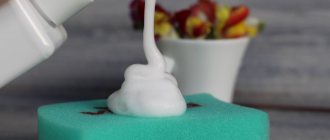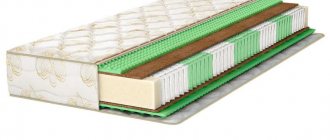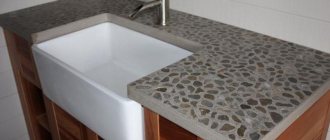Share on social media networks:
Nothing refreshes the interior of a room more than light, delicate tulle, dazzling with its whiteness. Despite the availability of a huge number of window design options, white classic tulle remains for many years the number one favorite of many housewives. But unfortunately, this lightweight material has a “capricious character”, and over time, under the influence of sunlight, street dust, kitchen fumes and cigarette smoke, it acquires an unpleasant yellowish or grayish tint. We will tell you in this article how to bleach tulle at home quickly and without using special store-bought products.
Salt
This component is definitely found in everyone’s kitchen, so there shouldn’t be any problems preparing the cleanser. Fill a large basin with warm water (optimal temperature 30-40°C), add 4-6 tablespoons of table salt, 2 tablespoons of washing powder (preferably with a bleaching effect), stir well, and then place the contaminated product in it. It should be completely saturated with the solution, so leave the tulle in the basin for at least 5-6 hours. After the specified time has passed, rinse it with plenty of clean water and let it drain.
Please remember that salt bleaching takes quite a long time.
The advantages of the method include:
- economy (you don’t need expensive products for cleaning);
- availability (salt can be found in every person’s kitchen);
- harmlessness (suitable for people sensitive to chemicals, as it does not cause allergies).
There is only one drawback - this type of whitening takes quite a lot of time, so it is not suitable for those who want to get the job done quickly.
Blue
An excellent example of how to bleach old tulle at home is washing with the addition of blue. To begin with, the curtains should be washed by hand using laundry soap. This will clean the fabric from dust and surface contaminants. Fill a bucket or bowl with 8-10 liters of water, add half a teaspoon of blue water and stir thoroughly. The product must dissolve well, otherwise stains may form on the fabric. Place the tulle in the prepared solution and let stand for 1-2 minutes, constantly stirring and turning it over, and then rinse under running cold water.
An excellent example of how to bleach old tulle at home - washing with the addition of blue
An alternative to this method is machine washing. It is enough to load the product into the drum along with the powder, select the delicate mode, and pour 0.5-1 capful of blue into the special compartment for the conditioner. This way, you don't have to spend your personal time doing laundry.
So, we can highlight the following advantages:
- efficiency (as a result you will get clean, snow-white tulle);
- bleaching will not take much time, since you do not have to soak the product for several hours;
It is enough to load the product into the drum along with the powder, select the delicate mode, and pour 0.5-1 capful of blue into the special compartment for the conditioner
- economy (blue is quite cheap).
At the same time, we must not forget about the disadvantages:
- finding bluing in household chemical stores and supermarkets is quite problematic, so searching for the product may take some time;
Care must be taken to ensure that the blue is completely dissolved in the water.
- You need to carefully ensure that the blue is completely dissolved in the water. Even the smallest crystals can leave stains that are difficult to remove on fabric, so this method is best used when washing by hand.
Traditional methods of bleaching tulle curtains
Grandma's bleaching methods, proven over decades, effectively remove yellowness from even old curtains. They are safe, do not cause allergic reactions, and are suitable for washing natural, delicate, and synthetic fabrics. The only drawback of traditional methods is the longer bleaching process.
Salt
Soaking with salt removes dust, stains, and greasy marks from curtains.
Soak the tulle in a saline solution with added powder
Non-iodized coarse salt is suitable for bleaching. What to do:
- Dilute ½ tbsp in 10 liters of water. salt and powder.
- Soak the tulle for 12 hours.
- Carefully wash the tulle, rinse, and let the dirty water drain.
- Re-wash your curtains by machine or by hand.
Zelenka
Use a solution of brilliant green as a final rinse to restore the whiteness of the curtains:
- Pour 10 drops of brilliant green into a glass of cool water, add 60 g of salt. Mix thoroughly until all components are dissolved.
- Pour the mixture into a bowl of cold water and stir.
- Immerse clean tulle in the basin for 5 minutes. Make sure that the entire fabric is covered with the composition.
- Without rinsing, hang the curtains to dry.
Important ! When working with dye, be extremely careful so that you do not have to remove additional stains.
Ammonia and hydrogen peroxide
The composition effectively cleans nylon tulle, curtains made of chiffon, polyester, organza, without damaging the fibers.
Method 1. For slightly yellowed tulle:
- Make a solution of 5 liters of water, 30 ml of ammonia, 60 ml of peroxide.
- Soak the curtain for 30 minutes.
- Rinse in cool water and hang to dry.
Method 2. Soaking heavily damaged tulle overnight:
- Dilute a bottle of ammonia in 10 liters of water heated to 40 degrees.
- Soak the tulle overnight.
- Rinse the fabric in the morning.
Method 3. Machine whitening:
- Set to a delicate wash cycle with pre-soak.
- Place the powder in the main wash compartment.
- Pour a bottle of ammonia into the drum of the machine.
- Run the cycle with an additional rinse.
Starch
Excellent for bleaching nylon tulle.
Whenever soaking tulle, carefully monitor the time
The product not only returns whiteness and original appearance, but also emphasizes the relief and texture of the fabric:
- Make a solution of 300 g of starch and 10 liters of warm water.
- Soak pre-washed curtains for 5-7 hours.
- After this, carefully, without twisting, wring out the curtains: hold one edge in your hand, squeeze the fabric tightly with the other hand and run along the entire length, driving off any remaining product.
- Hang to dry.
Blue
It has an optical whitening effect by imparting a slight blue tint to the material:
- Dilute the product according to the directions on the label. First dissolve the powdered blue in a glass of water, then pour into a basin. The liquid product can be immediately diluted in a rinse container.
- Rinse the tulle alternately in clean and blue water. Hang without squeezing.
Boric acid
Suitable for soaking tulle made of any material.
Soak the curtains in boric acid (50–60 ml per 10 liters of water) for 2 hours. Rinse with cool, clean water.
Potassium permangantsovka
A solution of potassium permanganate bleaches old, heavily soiled tulle. Can be used as the final stage after boiling and washing:
- Dissolve a package (5 g) of potassium permanganate in a glass of water, make sure there is no sediment.
- Pour into a bowl with 10 liters of water. You should get a pale pink solution.
- Soak the curtains for 30 minutes.
- Wash carefully in a solution with laundry soap.
- Rinse with fresh water.
Aspirin
Crush aspirin tablets and mix with powder
The product is suitable for whitening old stains and restoring cleanliness to heavily soiled curtains, even from delicate fabrics:
- Crush 10 tablets.
- Add them to machine washable laundry detergent.
- Start the wash cycle.
Curdled milk
Used for bleaching natural linen or cotton curtains:
- Wash the curtains as usual.
- Soak the product for a day in yogurt. The product should completely cover the fabric.
- Rinse in cool water, changing the water several times.
- Add fabric softener during the final rinse to remove sour odors.
- Dry in the sun.
Laundry soap
Helps whiten gray material on curtains made of any fabric:
- Generously rub the tulle with soap. Add some water.
- Leave for a day, periodically soaping and wetting the material with water.
- Rinse thoroughly with vinegar.
Lemon acid
The composition is suitable for bleaching natural fabrics:
- Make a solution of 3 liters of water, 50 ml of lemon juice (or 2 bags of acid), 200 ml of hydrogen peroxide.
- Pour the mixture into the drum of the automatic machine, load the tulle.
- Select cold rinse mode.
Zelenka
Using brilliant green will help you effectively bleach tulle at home and give it its original appearance. This method is one of the most popular and has good reviews. Fill a glass with warm water and add 3-5 drops of ordinary greenery. Stir the solution and leave for a few minutes. Pay attention to the presence of sediment: if there is none, you can safely pour the contents of the cup into a bowl of warm water.
Using brilliant green will help you effectively bleach tulle at home and give it its original appearance.
Otherwise, the product must be thoroughly stirred, wait until completely dissolved, and then pour into a basin through a sieve made of several layers of gauze. Before bleaching, tulle must be thoroughly washed and stubborn stains removed. As soon as all preparations are completed, place it in a container with the green solution and leave for 5 minutes, turning constantly. Then all you have to do is rinse the curtain, let the excess water drain and hang it up.
The advantages of the method are as follows:
- accessibility (green stuff is included in every first aid kit);
- economy (a bottle of green diamond has a low cost);
- whitening speed (the procedure will take no more than 30 minutes);
- efficiency (the tulle will look like new).
If you do everything right, you won't notice a single flaw. Problems can only arise if you don't mix the solution well and the crystals don't melt in the water.
Before bleaching, tulle must be thoroughly washed and stubborn stains removed.
Important! Due to such negligence, green spots or stains may form on the canvas, so be extremely careful and follow the instructions.
Ammonia and hydrogen peroxide
Let us immediately note that this method is intended exclusively for thick cotton curtains. So, fill the washing container with water heated to 60°C, add a tablespoon of ammonia and 3 tablespoons of hydrogen peroxide to it, and then mix thoroughly. Dip the tulle into the resulting solution and let stand for 30-40 minutes. Please note that the product should first be washed using detergents to remove dust and other contaminants. After the specified time, all you have to do is rinse the fabric, let it drain and squeeze out gently.
It should be remembered that this method is intended exclusively for thick cotton curtains.
Pros:
- low cost (such bleaching will cost you 10 rubles);
- effectiveness (the effect is noticeable after the first application);
This whitening will cost you 10 rubles
- speed of cleaning (you don’t have to soak the tulle overnight);
- availability (ammonium and peroxide are sold in every pharmacy).
The only disadvantage is that this method is not universal, so it cannot be used for synthetic fabrics.
Causes of pollution: why tulle loses its purity and freshness
When starting to bleach curtains, find out the reasons why the fabric has lost its whiteness and freshness, evaluate the nature and degree of contamination.
The degree of bleaching depends on the type of contamination
Reasons for the appearance of yellowness, grayness, spots, stains on tulle:
- dust coming through open windows;
- kitchen fumes;
- small children, animals;
- smoking households;
- dust settling on the curtains during dry cleaning of the house;
- improper whitening and skin care products;
- violation of temperature conditions during washing and ironing;
- fabric reaction to sunlight, heating devices.
Start bleaching the fabric after thoroughly washing the product and removing stains. Perhaps regular washing in a washing machine with a high-quality detergent will be enough to restore the original cleanliness.
Starch
Another example of how to achieve excellent results using improvised means. Before bleaching the tulle, wash it in the washing machine to get rid of dust and stains. Dissolve 250 grams of potato starch in a bowl of warm water. Once all preparations are completed, dip the tulle into the solution and leave for 5-7 hours. After this time, let the water drain and then hang the curtains without squeezing them.
Before bleaching the tulle, wash it in the washing machine to get rid of dust and stains.
The following advantages can be highlighted:
- low cost (whitening will cost a few rubles);
- accessibility (starch can be found even in a small store);
Whitening will take a few hours, but the results are worth it.
- the tulle will acquire its original appearance and will keep its shape perfectly;
Important! Of course, you will have to set aside several hours for whitening, but the result is worth it.
How to bleach tulle in a washing machine?
To effectively bleach tulle, use the following tips:
- Before washing curtains, be sure to shake them free of dust.
- Soak curtains that are too dirty with soapy water or hot water with salt (4 tablespoons of salt per 5 liters of water) overnight.
- Wash curtains on a delicate cycle and a water temperature of 30 degrees.
- For bleaching with a washing machine, regular washing powder and 2 drops of ammonia are suitable. An alternative to ammonia is 5-10 tablets of hydrogen peroxide.
- You can add non-chlorine bleach to your washing machine.
- Wash curtains by folding them several times until they are the size of a small rectangle. We recommend placing the folded curtain inside a special bag so that the fabric does not become deformed, and at the same time this will help facilitate the ironing process after washing.
- When rinsing, add 2-3 drops of brilliant green to cold water.
- Do not turn on the spin function in the washing machine.
- After finishing washing, wrap the curtains in a white sheet and wring them lightly without twisting them.
- Hang damp curtains on a curtain rod to dry.
Potassium permangantsovka
This method has been known since ancient times, but has not yet lost its relevance. An auxiliary element in this recipe will be laundry soap, so first grate a 100 gram bar on a fine grater. Dilute a few crystals of potassium permanganate in a glass of water, mix well and pour into a bowl of warm water. Add soap shavings there. You should end up with pale pink water that is foamy. Soak the tulle in it for 20-30 minutes, and then wash it as usual. Don't forget to rinse the product thoroughly.
The whitening procedure will not take more than 40 minutes
Advantages:
- the result lasts for a long time;
- The whitening procedure will not take more than 40 minutes.
Flaws:
- purchasing potassium permanganate is quite problematic;
- If the crystals do not dissolve well, stains may form on the fabric.
Laundry soap
If you still haven’t decided how to bleach nylon tulle at home because you are concerned about the safety of such delicate fabric, use the following method. Grate the soap on a fine grater, place the shavings in a pan of water and boil. Nylon does not tolerate high temperatures well, so the soap emulsion must be diluted with cool water before use. Soak the yellowed curtain in a warm solution for 6-8 hours, stir and turn it over every hour. After the time has passed, all you have to do is rinse the product and let it dry.
Grate the soap on a fine grater, place the shavings in a pan of water and boil
The advantages include:
- delicacy (the product is suitable for bleaching even the most capricious materials);
- low cost (laundry soap has a fairly low cost).
On a note! The main disadvantage is the need for long soaking, which significantly increases the amount of time that will have to be spent on the procedure.
We use chemical bleaches
The advantage of industrial bleaches is the restoration of fabric whiteness without wasting time and effort. In addition to bleaching, chemicals can remove complex household stains. The only drawback is that frequent use leads to destruction of the tissue structure. When using bleaches, it is important to observe the dosage and time of the soaking procedure. Follow the safety rules:
- Wear rubber gloves on your hands.
- Do not experiment with mixing chemicals.
- Before washing, test a small amount of the substance on an inconspicuous area of the fabric.
To bleach tulle curtains use:
- Chlorine-containing bleaches. They are used for products made from natural materials.
- Optical brighteners. They do not restore the whiteness of the fabric, but only create the effect of whiteness. This is done thanks to the coloring pigment.
- Oxygen products are preparations that contain peroxide.
Note: how to wash a wedding dress
After using products with chlorine, additionally rinse the fabric with conditioner or vinegar.
Digestion
This is a rather radical, but effective method. It is recommended to resort to it only in severe cases, when it was not possible to get rid of yellowness using the above methods. Take the required amount of water into an iron bucket, add the powder, and then put the tulle in it. Bring the solution to a boil, and then simmer for an hour over low heat, stirring constantly.
The advantages of such bleaching are that it is cheap and effective, but the disadvantages include the need for constant presence at the container.
The advantages of such bleaching are its low cost and effectiveness, but the disadvantages include the need for constant presence at the container. In addition, only dense cotton fabrics can withstand this procedure.
Let's sum it up
Now you know how to bleach tulle at home quickly and efficiently, so you can “reanimate” yellowed fabric at any time and return it to its former beauty. By the way, the fight against stubborn pollution requires an integrated approach.
All the methods listed above will help revive yellowed fabric and return it to its former beauty.
If the methods described do not help get rid of yellowness, then use a number of procedures at once. First, use boiling, then rinsing in blue, and finally soak the product in a starch solution. After such multi-stage bleaching, your tulle will definitely shine clean. Good luck!
Which whitening method should I choose?
To bleach tulle effectively at home, you need to choose a method and means based on the type of fabric. Today, the most common tulles are made of nylon and organza.
Organza
Organza is a beautiful, but very capricious fabric. This material does not tolerate contact with hot water and aggressive industrial bleaches. Among the folk remedies you can use organza tulle for whitening:
- Soaking in a solution of hydrogen peroxide and ammonia.
- Rinse in a saline solution with the addition of brilliant green.
- Rinse with blue solution.
We will provide whitening recipes using folk remedies below.
Capron
Nylon is a delicate synthetic material. It needs careful washing and delicate bleaching. Nylon cannot be washed at high temperatures - maximum 30 degrees, rpm speed should not exceed 400.
It is also impossible to use industrial bleaches for this material, as they can play a cruel joke on it and damage it irreparably. Among folk remedies, you can use only those that provide a stable and reliable effect even in cold water.
Capron is not afraid:
- Washing and soaking in saline solution.
- Rinse in a solution of potassium permanganate.
- Rinse in a solution of brilliant green.
Important! Voile curtains, created by weaving thin threads, quickly become dirty. To avoid damaging delicate fabrics when bleaching, wash curtains in water with the addition of hydrogen peroxide and ammonia (in a ratio of 1:2). Let the tulle sit in the solution for half an hour, then rinse it thoroughly and let it dry.
Preparing any whitening composition at home will not take much time, and the pleasant snow-white result will last for a long time. Let's look at the most popular whitening recipes.
Important! Even a sparklingly clean tulle or curtain will look tasteless in the interior if it is wrinkled or hung anyhow. Therefore, we also invite you to familiarize yourself with interesting ideas and tips that will help you bring the interior of your room to perfection:
- How to straighten curtains by weight?
- How to hang tulle beautifully?










